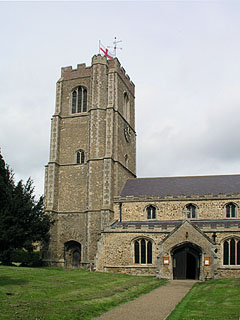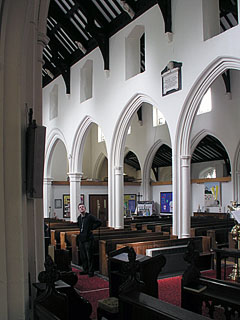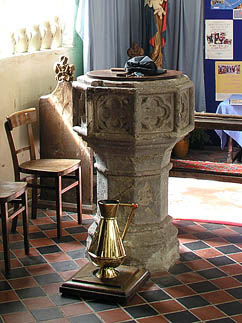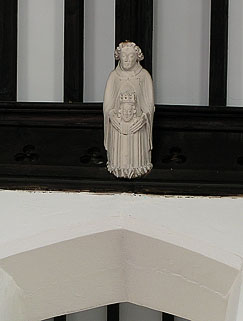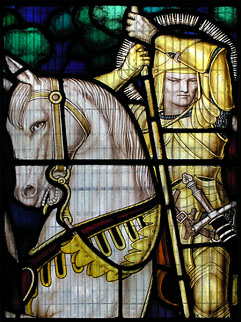Outside Cambridge itself, St George must have one of the least attractive settings of any of the churches in Cambridgeshire: it sits in a housing estate on the edge of the town, feeling ever so slightly forgotten. This is shame, because (externally, anyway) St George is a lovely building.
The 15th century tower can be seen from miles around, and is very fine: it is lofty, with cross-buttresses and an octagonal stair turret. Around the top is a brick parapet, and there are good large Perpendicular bell-openings. At the base, on the south side, there is a mysterious doorway: a large arch is set into the outer edge of the tower, within which is a section of wall containing a much smaller door. It is rather odd – one suggestion I’ve seen is that there was originally a walkway through the tower which was subsequently walled in.
The rest of the building is also pretty, especially seen from the south. It is built of a lovely pale honey-coloured stone, a lighter version of the carstone that runs in a band across the county from here to the Chilterns. There is a long low clerestory, and a pleasant little porch with benches on either side.
Inside, my first reaction was one of surprise: unless you walk round the church before entering, you are unlikely to realise that there are in fact two naves and two aisles, and that the interior is therefore much larger than it appears from the outside. The southern aisle and nave are the 15th century originals, but the northern additions (added in 1857) are very well-done, with the pillars being very good copies of the original medieval ones. Each nave has a clerestory, with the original north clerestory now devoid of tracery and glass and connecting the two roof spaces.
Above the clerestory on the south side is a collection of small figures on the walls, painted white and carrying an interesting collection of objects: crowns, mitres, scrolls and even a head in one case. Above those, there is a nice black and white timber roof. The tower sits at the west end of the original nave, of course, and has a large tower arch.
This is now mostly walled in, but we could see up into a ringing chamber through the top of the archway. In the corresponding part of the north nave is a parish room, into which one of the tower buttresses descends gigantically. Have I ever mentioned how much I like it when tower buttresses sit inside church buildings? It gives a real sense of the solidity of the buildings, I think. The new north aisle is now also walled off to provide an extension to the parish room: quite sensible, since there’s more room in the naves than could possibly be needed, I’m sure.
Aside from its size, and the interesting effect of the double nave, there’s not actually that much to see in St George. I did note a few things, though. There is a big parish chest in the north nave which had ‘1672’ written out in ironwork on the lid. In the south aisle, there is an octagonal font of familiar Perpendicular design at the west end, and the remains of an old chapel at the east end. This must originally have been quite nice – there’s a big broad Perpendicular arch separating it from the chancel in its north wall, and on either side of the east window are the remains of niches (though nothing survives save slight indentations on the walls). The present congregation have made good use of it; there’s a fine golden altar-cloth on the altar, and behind it a modern reredos depicting the Holy Family surrounding an incongruously grand manger. (I actually found it a bit sickly to look at, but I’m sure that’s just me.)
Leading off the chapel, you can see the upper part of the old rood stair leading up to where the rood loft would once have crossed the chancel arch. Sadly, the screen is now long gone. It would have been wide, though not very tall – the archway is very broad. Just east of the north respond, I found a nice little piece of stone commemorating one Richard Ward who was buried there after dying in 1636 at the age of 26.
The chancel itself is surprisingly small. It doesn’t help that the glass is very dark, and that the huge organ dominates the space. Almost no original fittings survive here: I did wonder about the little piscina on the south wall, but even if it is medieval it is swamped by Victoriana, such as the grand marble reredos.
Littleport is one of the churches I’ve visited with BBC Radio Cambridgeshire to record a programme for their ‘Church Detectives’ series. The aim of the series is to uncover the ‘people stories’ connected with the churches of the county, and Littleport seems to be unusually well supplied with those.
Most famously, there is the story of the Littleport Riots in 1816, when a starved population rose up and took control of Littleport and Ely before being defeated by a detachment of dragoons sent from Bury St Edmunds (bloody Suffolk, eh!). The full story is quite exciting, and an excellent version can be found on Adam Strawson’s excellent site about the town.
The 1816 riot wasn’t the first breach of the peace in Littleport: the area
seems to have had a reputation for disorderliness for a very long time. In
1381, two Littleport men named Thomas Ixning and Thomas Lyncoln led a mob
which burned the Bishop of Ely’s court rolls at his manor of Balsham. In
June of 1638 about two hundred Littleport men gathered in a nearby fen and,
in the words of the local Justice of the Peace, ‘that their assembly was
appointed to throw down ditches which the drainers had made for enclosing
their fen ground from the common, which was left to the inhabitants…’.
Hurrah for the men of Littleport! Modern day rebels might also be interested to know that William Harley, father of the William Sylvester Harley who founded Harley-Davidson motorcycles, was born here in Littleport: the connection is commemorated with a sculpture of a motorbike to the south of the churchyard.
St George is kept locked, but the congregation
endeavour
to keep it open on
Tuesdays for visitors
